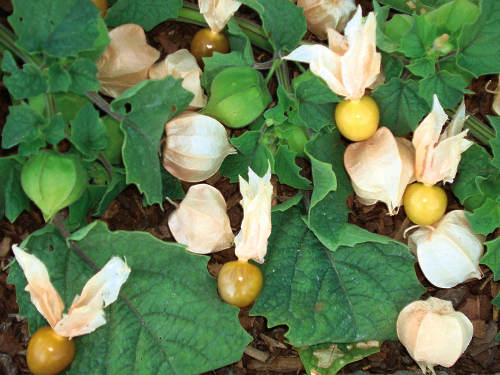about 2 feet tall
As ground cherries grow, they grow wide rather than tall. Expect ground cherry plants to grow about 2 feet tall and 2 feet wide. If you don't want them to sprawl, use the smallest tomato cages you can find to support them and prevent them from spreading.
aphids!
selenium!
Some species are self-incompatible and require pollen from other plants to bear fruit.
Ground cherries are an essential crop in our garden. We start the seeds indoors in late March, but note that they can be tricky to germinate (try bottom heat). Once growing, you can expect a bumper crop of super-sweet fruits from mid-summer until frost
Unique vegetables to grow in your garden
covering the seed trays with clear plastic wrap and placing them on top of my fridge to keep warm. Germination can take 2 to 3 weeks.
How to grow ground cherries in a garden
Ground cherry plants are best started under cover and planted out. Sow seeds indoors 6–8 weeks before the last frost. Plant seeds ¼ inch deep.
seedsavers
Ground cherries begin to ripen about 70 days after transplanting and continue producing until frost.
Start seeds indoors 6–8 weeks before the last frost date.
I start my ground cherry seedlings in mid-April.
In late May or early June, I harden off transplants for at least five days.
magazine.cog.ca
Aunt Molly's Ground Cherry
65 days. Polish heirloom variety has an unusually fine flavor—very sweet with a nice hint of tartness. 1/2-3/4-inch fruit is enclosed in a papery husk which drops to the ground when fully ripe. High pectin content makes this one an excellent choice for pies and preserves.
Review: I have tried ground cherries from the grocery store on three separate occasions for a premium price and they were all terrible, however after reading the reviews of Aunt Molly's I thought I would give them a try. Following suggestions, I harvest them only after they fall, and then leave them on the counter for several days. Wow, they are delicious! They are sweet and tart a the same time, with a neat texture. Some are very small but still delicious. This will now be a regular in my garden.
Location : Canada Sudbury
rareseeds
Cape Gooseberry Husk Tomato
(Physalis peruviana) This once forgotten superfruit is experiencing a resurgence in popularity. We are thrilled to see the scrumptious, pineapple flavored fruits in gardens and grocery stories across the globe. The cape gooseberry is native to Brazil and was grown in England by 1774. It was cultivated by settlers at the Cape of Good Hope before 1807. The delicious yellow-orange fruit grows inside paper-like husks that are easy to peel. They are great dipped in melted chocolate or made into pies and preserves.
Review:
Love these little berries. Never had a problem growing them here in the Polar Vortex (which in Zone 5b, has a warm growing season of 3 1/2 months if we're lucky). They do mature about the same time as larger tomatoes do mid-Aug to Sept. I start them about the same time I start tomatoes indoors in late March. I tended not to grow them near tomatoes in the garden and got great harvests. Instead, I grew them in large pots. Pests weren't ever an issue as I also grew basil and French marigolds nearby. They re-seed, too. Never have to buy seed again. Ate them like grapes (they do taste like pineapple when ripe and do eat them when they're golden ripe) although, I'd love to try making a jam.
Location : United States WI Southeast
rareseeds
Goldie
Organic Husk Cherry Seed
Small orange berry with a husk.
A conversation piece at markets, well liked by children. This old-fashioned tomato family member bears 1/2– 3/4" sweet golden berries inside papery husks, resembling small, straw-colored Japanese lanterns. The flavor is quite sweet and a bit wild. Plants are profusely branching, prolific, and drop ripe fruits. Fruits can be eaten raw, dried like raisins, frozen, canned, or made into preserves, cooked pies, and desserts. Organically grown. LATIN NAME
Physalis pruinosa. Days To Maturity 75 Days
johnnyseeds
 MBZ
MBZ

